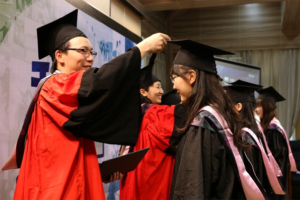Danilo de Melo Costa, Professor of the Master and Doctorate Program in Business Administration (PDMA) at Universidade FUMEC and Centro Universitário Una, Belo Horizonte, MG, Brazil.

Image: Locies
Research aimed at understand the role of the economy and Projects 211 and 985 for the expansion of Chinese higher education, from the perspective of its main stakeholders: government leaders, professors and student leadership. The 211 project was born in 1993, through a series of government initiatives aimed at providing financial support to China’s top 100 universities to achieve the status of “world-class” universities. The intensification of more resources in 1998 for a select group of universities (initially 9, and later moving to 39), was then called project 985. This research was conducted by the researcher Danilo de Melo Costa, between the years 2013 and 2014, in the context of his doctoral dissertation in business administration at the Federal University of Minas Gerais (UFMG), which aimed to understand the dynamics behind public funding of higher education in Brazil, Canada and China. It’s evident the economic growth of China in the last decades, as well as its higher education system, which motivated the interest to understand the relationship between them, as well as the government projects 985 and 211, which had the objective of increasing the financial contribution the universities chosen by the government.
The paper “Chinese higher education: the role of the economy and projects 211/985 for system expansion”, published in the journal Ensaio: Avaliação e Políticas Públicas em Educação (vol. 28, no. 109), highlighted issues involving the Chinese educational system. To understand this phenomenon, an exploratory and qualitative research was developed, based on interviews with three Chinese government managers, and the application of a non-structured questionnaire to eight professors specialized in Chinese higher education and to a student leadership.
The results showed that investments in higher education were predominant for the country’s economic growth, which was representative from a quantitative perspective. However, also aiming at qualitative growth, projects 211 and 985 were created, allocating a significant amount of resources to the selected institutions. This position makes China today a benchmark model for other countries that wish to achieve economic and intellectual progress.
The conclusion from the participants’ perception is that these policies represent a new era in the expansion of the quality of education offered by the Chinese universities involved, which are beginning to be recognized internationally. The participants also defended the need to limit the investment to a select group of universities in order to obtain better results, because if it were a distribution of transfers to a larger group of universities, the objectives might not be achieved. China’s great challenge now, as it has the largest educational system on the planet, is to guarantee the absorption of recent graduates in their respective areas of knowledge. For future research, it is intended to understand the impacts of the new project, called “Double First Class University Plan”, which aims to further increase investment in the main Chinese universities.
References
COSTA, D. M. Efficiency of public policies for higher education: the case of people’s republic of China. Organizações em Contexto [online], 2019. vol. 15, no. 29, pp. 155-190, e-ISSN: 1982-8756 [viewed 29 September 2020]. DOI: 10.15603/1982-8756/roc.v15n29p155-190 Available from: https://www.metodista.br/revistas/revistas-metodista/index.php/OC/article/view/8189
COSTA, D. M. and BARBOSA, F. V. Efficiency of public policies for financing higher education: a comparative study among Brazil, Canada and China. Meta: Avaliação [online], vol. 10, no. 28, pp. 106-138. [viewed 29 September 2020]. DOI: 10.22347/2175-2753v10i28.1370. Available from: http://revistas.cesgranrio.org.br/index.php/metaavaliacao/article/view/1370
ZHA, Q. Understanding China’s move to mass higher education from a policy perspective. In: HAYHOE, R., et al. Portraits of 21st century Chinese Universities: in the move to mass higher education. Hong Kong: Springer, 2011. Chapter 1.
To read the article, access
COSTA, D. de M. and ZHA, Q. Chinese higher education: the role of the economy and Projects 211/985 for system expansion. Ensaio: aval.pol.públ.Educ. [online]. 2020, vol. 28, n. 109, pp. 885-908, ISSN: 1809-4465 [viewed 3 October 2020]. DOI: 10.1590/s0104-40362020002802657. Available from: http://ref.scielo.org/bh23bs
External links
Ensaio: Avaliação e Políticas Públicas em Educação – ENSAIO: www.scielo.br/ensaio
Facebook Ensaio: https://www.facebook.com/ensaiorevista/
Twitter Ensaio: https://twitter.com/revista_ensaio
Blog Ensaio: https://rensaio.wordpress.com/
Como citar este post [ISO 690/2010]:


















Recent Comments